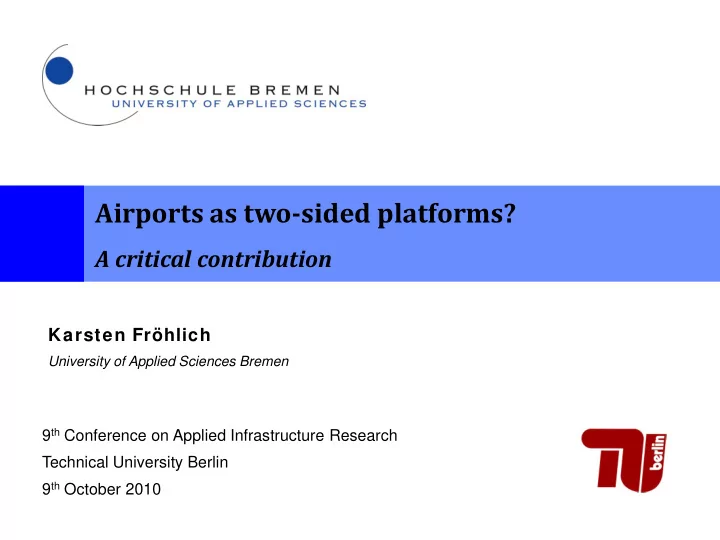

Airports as two-sided platforms? A critical contribution Karsten Fröhlich University of Applied Sciences Bremen 9 th Conference on Applied Infrastructure Research Technical University Berlin 9 th October 2010 1
Introduction (1) • Increasing literature and applications “two- sided markets” or “platforms” • Applied to airports – Implications for regulation • Are airports “two-sided platforms” (TSP)? – What are the implications for regulation 2
Outline • Two-sided markets • Application to airports • Non-aviation revenues • Discussion and policy implications • Conclusion 3
Outline • Two-sided markets • Application to airports • Non-aviation revenues • Discussion and policy implications • Conclusion 4
“Two-sided markets” (1) • Classic example: dating agency – Two groups of consumers – Men and women – Both yield utility from using the platform – Utility also increases with number of users from the other group 5
“Two-sided markets” (2) • To function, platform must bring “both parties on board” • Similar to network externalities – telephones – Here: indirect usage externalities • Pricing of paramount importance – Particularly if cross-usage externalities are unevenly distributed 6
“Two-sided markets” (3) • Further (cited) examples: – Advertising platforms – eBay – Operating systems (Windows) 7
“Two-sided markets” (4) • Roche & Tirole (2003) define two-sidedness in such a way that the volume of transactions (output) fluctuates if the price structure (relative prices between the two groups) changes whereas the price level (defined as the total revenues from both sides of the platform) remains unaffected. If that does not hold true the market is said to be one-sided. 8
“Two-sided markets” (5) • Evans and Schmalensee (2007) point out: TSP arise where two parties face externalities; not be solved differently (or with lower transaction costs) than through the platform 9
Outline • Two-sided markets • Application to airports • Non-aviation revenues • Discussion and policy implications • Conclusion 10
Application to airports (1) • Are airports TSP? – Platform for airlines and passengers – Passengers gain from destinations, …; airlines gain from greater “plateau” of passengers • Case made by Gillen (2009) – Related (but not limited) to non-aviation revenues 11
Application to airports (2) • Passenger pay no entry fee – Bear a passenger fee indirectly • But: passengers do get sold something – Airport does not “bring together” • No cross-usage externalities – Tickets is pre-purchased (e.g. through website) • Airport is (essential) input for airlines – Charges are levied accordingly 12
Application to airports (3) • What if airports charges passengers directly – E.g. for service of being “handled” through to the aircraft • Vertical relationship remains unaffected – Products are (perfect) complements – Decision to buy ticket reflects willingness to “buy airport” 13
Application to airports (4) • Therefore: vertical externalities – No cross-usage externalities • Similar consequences regarding pricing – Airport pricing influences airline pricing and passenger demand – Airline product decisions have impact on airport revenues 14
Outline • Two-sided markets • Application to airports • Non-aviation revenues • Discussion and policy implications • Conclusion 15
Non-Aviation revenues (1) • Airports also sell non-aviation products – Food and beverages, clothing, … • Different products, hence no two-sided market • Airlines seek passengers, not shopping passengers • Passenger fly, shoppers shop – Maybe different for revenue sharing 16
Non-Aviation revenues (2) • Complementarity between aviation and non-aviation – Possibly largely through income effects – Car parking related to aviation product from consumer’s point of view • Starkie (2001) uses complementary “revenue streams” instead of “demand complementarity” 17
Non-Aviation revenues (3) • Price reductions in aviation product increase in demand for non-aviation products – Reverse? • Complementarity has impact on pricing – 18
Outline • Two-sided markets • Application to airports • Non-aviation revenues • Discussion and policy implications • Conclusion 19
Discussion (1) • Vertical externalities and coordination problems – No cross-usage externalities • Complementary demands for aviation and non-aviation products • Airports not TSP • But what are the effects of the above? 20
Discussion (2) • Standard model for multi-product firm: – Depending on cross-price elasticities and economies in production optimal prices diverge from single product situation – One product boosts demand of another • If cross-price effects and scope economies are large Starkie (2001) argument 21
Discussion (3) • Due to vertical relationship – Double marginalization – Vertical externalities – individual decisions (by airlines and/or airports) might not optimal from integrated point of view • Implications for policy: – Regulation of aviation prices negatively impacts non-aviation prices 22
Discussion (4) – Price structure is important, airports might not optimize – Airports’ negotiated contracts might impede downstream competition – Regulation should assess impact of non- aviation business 23
Outline • Two-sided markets • Application to airports • Non-aviation revenues • Discussion and policy implications • Conclusion 24
Conclusion (1) • Airports are not TSP • Better described by vertical relationship – With multi-product profit function • Have similar (if not identical) effects as two-sided concept – Effect of airport’s charges feed through to passengers 25
Conclusion (2) • Problems such as double marginalization usually “irrelevant” in “normal” industries – Here: possible impediments – Price regulation, implicit price structure regulation • With complementary demands – Lower price for aviation product – But: depend on size and direction of complementary effects 26
Conclusion (3) • Concept of two-sided markets does not enrich airport regulation discussion – Models to analyze airports are available – Effects of vertical relationship and complementary products resemble TSP effects 27
Thank you very much! Karsten Fröhlich University of Applied Sciences Bremen Werderstraße 73 D – 28199 Bremen Tel.: 0421/5905-4283 Fax: 0421/5905-4815 Email: karsten.froehlich@hs-bremen.de 28
Recommend
More recommend